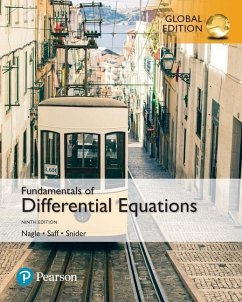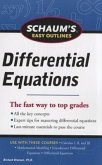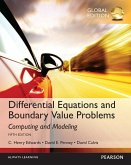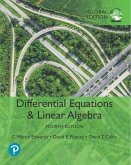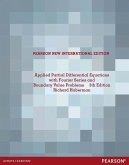Schade – dieser Artikel ist leider ausverkauft. Sobald wir wissen, ob und wann der Artikel wieder verfügbar ist, informieren wir Sie an dieser Stelle.
- Broschiertes Buch
- Merkliste
- Auf die Merkliste
- Bewerten Bewerten
- Teilen
- Produkt teilen
- Produkterinnerung
- Produkterinnerung
Fundamentals of Differential Equations presents the basic theory of differential equations and offers a variety of modern applications in science and engineering. This flexible text allows instructors to adapt to various course emphases (theory, methodology, applications, and numerical methods) and to use commercially available computer software.
Andere Kunden interessierten sich auch für
![Schaum's Easy Outline of Differential Equations, Revised Edition Schaum's Easy Outline of Differential Equations, Revised Edition]() Richard BronsonSchaum's Easy Outline of Differential Equations, Revised Edition22,99 €
Richard BronsonSchaum's Easy Outline of Differential Equations, Revised Edition22,99 €![Fractional Difference, Differential Equations, and Inclusions Fractional Difference, Differential Equations, and Inclusions]() Said Abbas (Professor, Department of Mathematics, Tahar Moulay UnivFractional Difference, Differential Equations, and Inclusions188,99 €
Said Abbas (Professor, Department of Mathematics, Tahar Moulay UnivFractional Difference, Differential Equations, and Inclusions188,99 €![Differential Equations and Boundary Value Problems: Computing and Modeling, Global Edition Differential Equations and Boundary Value Problems: Computing and Modeling, Global Edition]() C. EdwardsDifferential Equations and Boundary Value Problems: Computing and Modeling, Global Edition111,99 €
C. EdwardsDifferential Equations and Boundary Value Problems: Computing and Modeling, Global Edition111,99 €![Differential Equations and Linear Algebra, Global Edition Differential Equations and Linear Algebra, Global Edition]() C. EdwardsDifferential Equations and Linear Algebra, Global Edition116,99 €
C. EdwardsDifferential Equations and Linear Algebra, Global Edition116,99 €![Elementary Differential Equations Elementary Differential Equations]() Earl RainvilleElementary Differential Equations87,99 €
Earl RainvilleElementary Differential Equations87,99 €![Elementary Differential Equations with Boundary Value Problems Elementary Differential Equations with Boundary Value Problems]() C. EdwardsElementary Differential Equations with Boundary Value Problems118,99 €
C. EdwardsElementary Differential Equations with Boundary Value Problems118,99 €![Applied Partial Differential Equations with Fourier Series and Boundary Value Problems Applied Partial Differential Equations with Fourier Series and Boundary Value Problems]() Richard HabermanApplied Partial Differential Equations with Fourier Series and Boundary Value Problems109,99 €
Richard HabermanApplied Partial Differential Equations with Fourier Series and Boundary Value Problems109,99 €-
-
-
Fundamentals of Differential Equations presents the basic theory of differential equations and offers a variety of modern applications in science and engineering. This flexible text allows instructors to adapt to various course emphases (theory, methodology, applications, and numerical methods) and to use commercially available computer software.
Produktdetails
- Produktdetails
- Verlag: Pearson Education Limited
- 9 ed
- Seitenzahl: 720
- Erscheinungstermin: 13. September 2018
- Englisch
- Abmessung: 255mm x 207mm x 37mm
- Gewicht: 1210g
- ISBN-13: 9781292240992
- ISBN-10: 1292240997
- Artikelnr.: 52958614
- Herstellerkennzeichnung
- Libri GmbH
- Europaallee 1
- 36244 Bad Hersfeld
- 06621 890
- Verlag: Pearson Education Limited
- 9 ed
- Seitenzahl: 720
- Erscheinungstermin: 13. September 2018
- Englisch
- Abmessung: 255mm x 207mm x 37mm
- Gewicht: 1210g
- ISBN-13: 9781292240992
- ISBN-10: 1292240997
- Artikelnr.: 52958614
- Herstellerkennzeichnung
- Libri GmbH
- Europaallee 1
- 36244 Bad Hersfeld
- 06621 890
1. Introduction
1.1 Background
1.2 Solutions and Initial Value Problems
1.3 Direction Fields
1.4 The Approximation Method of Euler
2. First-Order Differential Equations
2.1 Introduction: Motion of a Falling Body
2.2 Separable Equations
2.3 Linear Equations
2.4 Exact Equations
2.5 Special Integrating Factors
2.6 Substitutions and Transformations
3. Mathematical Models and Numerical Methods Involving First Order
Equations
3.1 Mathematical Modeling
3.2 Compartmental Analysis
3.3 Heating and Cooling of Buildings
3.4 Newtonian Mechanics
3.5 Electrical Circuits
3.6 Improved Euler's Method
3.7 Higher-Order Numerical Methods: Taylor and Runge-Kutta
4. Linear Second-Order Equations
4.1 Introduction: The Mass-Spring Oscillator
4.2 Homogeneous Linear Equations: The General Solution
4.3 Auxiliary Equations with Complex Roots
4.4 Nonhomogeneous Equations: The Method of Undetermined Coefficients
4.5 The Superposition Principle and Undetermined Coefficients Revisited
4.6 Variation of Parameters
4.7 Variable-Coefficient Equations
4.8 Qualitative Considerations for Variable-Coefficient and Nonlinear
Equations
4.9 A Closer Look at Free Mechanical Vibrations
4.10 A Closer Look at Forced Mechanical Vibrations
5. Introduction to Systems and Phase Plane Analysis
5.1 Interconnected Fluid Tanks
5.2 Elimination Method for Systems with Constant Coefficients
5.3 Solving Systems and Higher-Order Equations Numerically
5.4 Introduction to the Phase Plane
5.5 Applications to Biomathematics: Epidemic and Tumor Growth Models
5.6 Coupled Mass-Spring Systems
5.7 Electrical Systems
5.8 Dynamical Systems, Poincaré Maps, and Chaos
6. Theory of Higher-Order Linear Differential Equations
6.1 Basic Theory of Linear Differential Equations
6.2 Homogeneous Linear Equations with Constant Coefficients
6.3 Undetermined Coefficients and the Annihilator Method
6.4 Method of Variation of Parameters
7. Laplace Transforms
7.1 Introduction: A Mixing Problem
7.2 Definition of the Laplace Transform
7.3 Properties of the Laplace Transform
7.4 Inverse Laplace Transform
7.5 Solving Initial Value Problems
7.6 Transforms of Discontinuous Functions
7.7 Transforms of Periodic and Power Functions
7.8 Convolution
7.9 Impulses and the Dirac Delta Function
7.10 Solving Linear Systems with Laplace Transforms
8. Series Solutions of Differential Equations
8.1 Introduction: The Taylor Polynomial Approximation
8.2 Power Series and Analytic Functions
8.3 Power Series Solutions to Linear Differential Equations
8.4 Equations with Analytic Coefficients
8.5 Cauchy-Euler (Equidimensional) Equations
8.6 Method of Frobenius
8.7 Finding a Second Linearly Independent Solution
8.8 Special Functions
9. Matrix Methods for Linear Systems
9.1 Introduction
9.2 Review 1: Linear Algebraic Equations
9.3 Review 2: Matrices and Vectors
9.4 Linear Systems in Normal Form
9.5 Homogeneous Linear Systems with Constant Coefficients
9.6 Complex Eigenvalues
9.7 Nonhomogeneous Linear Systems
9.8 The Matrix Exponential Function
10. Partial Differential Equations
10.1 Introduction: A Model for Heat Flow
10.2 Method of Separation of Variables
10.3 Fourier Series
10.4 Fourier Cosine and Sine Series
10.5 The Heat Equation
10.6 The Wave Equation
1.1 Background
1.2 Solutions and Initial Value Problems
1.3 Direction Fields
1.4 The Approximation Method of Euler
2. First-Order Differential Equations
2.1 Introduction: Motion of a Falling Body
2.2 Separable Equations
2.3 Linear Equations
2.4 Exact Equations
2.5 Special Integrating Factors
2.6 Substitutions and Transformations
3. Mathematical Models and Numerical Methods Involving First Order
Equations
3.1 Mathematical Modeling
3.2 Compartmental Analysis
3.3 Heating and Cooling of Buildings
3.4 Newtonian Mechanics
3.5 Electrical Circuits
3.6 Improved Euler's Method
3.7 Higher-Order Numerical Methods: Taylor and Runge-Kutta
4. Linear Second-Order Equations
4.1 Introduction: The Mass-Spring Oscillator
4.2 Homogeneous Linear Equations: The General Solution
4.3 Auxiliary Equations with Complex Roots
4.4 Nonhomogeneous Equations: The Method of Undetermined Coefficients
4.5 The Superposition Principle and Undetermined Coefficients Revisited
4.6 Variation of Parameters
4.7 Variable-Coefficient Equations
4.8 Qualitative Considerations for Variable-Coefficient and Nonlinear
Equations
4.9 A Closer Look at Free Mechanical Vibrations
4.10 A Closer Look at Forced Mechanical Vibrations
5. Introduction to Systems and Phase Plane Analysis
5.1 Interconnected Fluid Tanks
5.2 Elimination Method for Systems with Constant Coefficients
5.3 Solving Systems and Higher-Order Equations Numerically
5.4 Introduction to the Phase Plane
5.5 Applications to Biomathematics: Epidemic and Tumor Growth Models
5.6 Coupled Mass-Spring Systems
5.7 Electrical Systems
5.8 Dynamical Systems, Poincaré Maps, and Chaos
6. Theory of Higher-Order Linear Differential Equations
6.1 Basic Theory of Linear Differential Equations
6.2 Homogeneous Linear Equations with Constant Coefficients
6.3 Undetermined Coefficients and the Annihilator Method
6.4 Method of Variation of Parameters
7. Laplace Transforms
7.1 Introduction: A Mixing Problem
7.2 Definition of the Laplace Transform
7.3 Properties of the Laplace Transform
7.4 Inverse Laplace Transform
7.5 Solving Initial Value Problems
7.6 Transforms of Discontinuous Functions
7.7 Transforms of Periodic and Power Functions
7.8 Convolution
7.9 Impulses and the Dirac Delta Function
7.10 Solving Linear Systems with Laplace Transforms
8. Series Solutions of Differential Equations
8.1 Introduction: The Taylor Polynomial Approximation
8.2 Power Series and Analytic Functions
8.3 Power Series Solutions to Linear Differential Equations
8.4 Equations with Analytic Coefficients
8.5 Cauchy-Euler (Equidimensional) Equations
8.6 Method of Frobenius
8.7 Finding a Second Linearly Independent Solution
8.8 Special Functions
9. Matrix Methods for Linear Systems
9.1 Introduction
9.2 Review 1: Linear Algebraic Equations
9.3 Review 2: Matrices and Vectors
9.4 Linear Systems in Normal Form
9.5 Homogeneous Linear Systems with Constant Coefficients
9.6 Complex Eigenvalues
9.7 Nonhomogeneous Linear Systems
9.8 The Matrix Exponential Function
10. Partial Differential Equations
10.1 Introduction: A Model for Heat Flow
10.2 Method of Separation of Variables
10.3 Fourier Series
10.4 Fourier Cosine and Sine Series
10.5 The Heat Equation
10.6 The Wave Equation
1. Introduction
1.1 Background
1.2 Solutions and Initial Value Problems
1.3 Direction Fields
1.4 The Approximation Method of Euler
2. First-Order Differential Equations
2.1 Introduction: Motion of a Falling Body
2.2 Separable Equations
2.3 Linear Equations
2.4 Exact Equations
2.5 Special Integrating Factors
2.6 Substitutions and Transformations
3. Mathematical Models and Numerical Methods Involving First Order
Equations
3.1 Mathematical Modeling
3.2 Compartmental Analysis
3.3 Heating and Cooling of Buildings
3.4 Newtonian Mechanics
3.5 Electrical Circuits
3.6 Improved Euler's Method
3.7 Higher-Order Numerical Methods: Taylor and Runge-Kutta
4. Linear Second-Order Equations
4.1 Introduction: The Mass-Spring Oscillator
4.2 Homogeneous Linear Equations: The General Solution
4.3 Auxiliary Equations with Complex Roots
4.4 Nonhomogeneous Equations: The Method of Undetermined Coefficients
4.5 The Superposition Principle and Undetermined Coefficients Revisited
4.6 Variation of Parameters
4.7 Variable-Coefficient Equations
4.8 Qualitative Considerations for Variable-Coefficient and Nonlinear
Equations
4.9 A Closer Look at Free Mechanical Vibrations
4.10 A Closer Look at Forced Mechanical Vibrations
5. Introduction to Systems and Phase Plane Analysis
5.1 Interconnected Fluid Tanks
5.2 Elimination Method for Systems with Constant Coefficients
5.3 Solving Systems and Higher-Order Equations Numerically
5.4 Introduction to the Phase Plane
5.5 Applications to Biomathematics: Epidemic and Tumor Growth Models
5.6 Coupled Mass-Spring Systems
5.7 Electrical Systems
5.8 Dynamical Systems, Poincaré Maps, and Chaos
6. Theory of Higher-Order Linear Differential Equations
6.1 Basic Theory of Linear Differential Equations
6.2 Homogeneous Linear Equations with Constant Coefficients
6.3 Undetermined Coefficients and the Annihilator Method
6.4 Method of Variation of Parameters
7. Laplace Transforms
7.1 Introduction: A Mixing Problem
7.2 Definition of the Laplace Transform
7.3 Properties of the Laplace Transform
7.4 Inverse Laplace Transform
7.5 Solving Initial Value Problems
7.6 Transforms of Discontinuous Functions
7.7 Transforms of Periodic and Power Functions
7.8 Convolution
7.9 Impulses and the Dirac Delta Function
7.10 Solving Linear Systems with Laplace Transforms
8. Series Solutions of Differential Equations
8.1 Introduction: The Taylor Polynomial Approximation
8.2 Power Series and Analytic Functions
8.3 Power Series Solutions to Linear Differential Equations
8.4 Equations with Analytic Coefficients
8.5 Cauchy-Euler (Equidimensional) Equations
8.6 Method of Frobenius
8.7 Finding a Second Linearly Independent Solution
8.8 Special Functions
9. Matrix Methods for Linear Systems
9.1 Introduction
9.2 Review 1: Linear Algebraic Equations
9.3 Review 2: Matrices and Vectors
9.4 Linear Systems in Normal Form
9.5 Homogeneous Linear Systems with Constant Coefficients
9.6 Complex Eigenvalues
9.7 Nonhomogeneous Linear Systems
9.8 The Matrix Exponential Function
10. Partial Differential Equations
10.1 Introduction: A Model for Heat Flow
10.2 Method of Separation of Variables
10.3 Fourier Series
10.4 Fourier Cosine and Sine Series
10.5 The Heat Equation
10.6 The Wave Equation
1.1 Background
1.2 Solutions and Initial Value Problems
1.3 Direction Fields
1.4 The Approximation Method of Euler
2. First-Order Differential Equations
2.1 Introduction: Motion of a Falling Body
2.2 Separable Equations
2.3 Linear Equations
2.4 Exact Equations
2.5 Special Integrating Factors
2.6 Substitutions and Transformations
3. Mathematical Models and Numerical Methods Involving First Order
Equations
3.1 Mathematical Modeling
3.2 Compartmental Analysis
3.3 Heating and Cooling of Buildings
3.4 Newtonian Mechanics
3.5 Electrical Circuits
3.6 Improved Euler's Method
3.7 Higher-Order Numerical Methods: Taylor and Runge-Kutta
4. Linear Second-Order Equations
4.1 Introduction: The Mass-Spring Oscillator
4.2 Homogeneous Linear Equations: The General Solution
4.3 Auxiliary Equations with Complex Roots
4.4 Nonhomogeneous Equations: The Method of Undetermined Coefficients
4.5 The Superposition Principle and Undetermined Coefficients Revisited
4.6 Variation of Parameters
4.7 Variable-Coefficient Equations
4.8 Qualitative Considerations for Variable-Coefficient and Nonlinear
Equations
4.9 A Closer Look at Free Mechanical Vibrations
4.10 A Closer Look at Forced Mechanical Vibrations
5. Introduction to Systems and Phase Plane Analysis
5.1 Interconnected Fluid Tanks
5.2 Elimination Method for Systems with Constant Coefficients
5.3 Solving Systems and Higher-Order Equations Numerically
5.4 Introduction to the Phase Plane
5.5 Applications to Biomathematics: Epidemic and Tumor Growth Models
5.6 Coupled Mass-Spring Systems
5.7 Electrical Systems
5.8 Dynamical Systems, Poincaré Maps, and Chaos
6. Theory of Higher-Order Linear Differential Equations
6.1 Basic Theory of Linear Differential Equations
6.2 Homogeneous Linear Equations with Constant Coefficients
6.3 Undetermined Coefficients and the Annihilator Method
6.4 Method of Variation of Parameters
7. Laplace Transforms
7.1 Introduction: A Mixing Problem
7.2 Definition of the Laplace Transform
7.3 Properties of the Laplace Transform
7.4 Inverse Laplace Transform
7.5 Solving Initial Value Problems
7.6 Transforms of Discontinuous Functions
7.7 Transforms of Periodic and Power Functions
7.8 Convolution
7.9 Impulses and the Dirac Delta Function
7.10 Solving Linear Systems with Laplace Transforms
8. Series Solutions of Differential Equations
8.1 Introduction: The Taylor Polynomial Approximation
8.2 Power Series and Analytic Functions
8.3 Power Series Solutions to Linear Differential Equations
8.4 Equations with Analytic Coefficients
8.5 Cauchy-Euler (Equidimensional) Equations
8.6 Method of Frobenius
8.7 Finding a Second Linearly Independent Solution
8.8 Special Functions
9. Matrix Methods for Linear Systems
9.1 Introduction
9.2 Review 1: Linear Algebraic Equations
9.3 Review 2: Matrices and Vectors
9.4 Linear Systems in Normal Form
9.5 Homogeneous Linear Systems with Constant Coefficients
9.6 Complex Eigenvalues
9.7 Nonhomogeneous Linear Systems
9.8 The Matrix Exponential Function
10. Partial Differential Equations
10.1 Introduction: A Model for Heat Flow
10.2 Method of Separation of Variables
10.3 Fourier Series
10.4 Fourier Cosine and Sine Series
10.5 The Heat Equation
10.6 The Wave Equation

